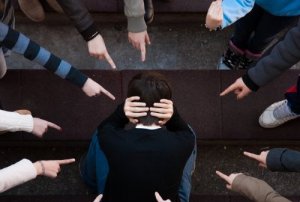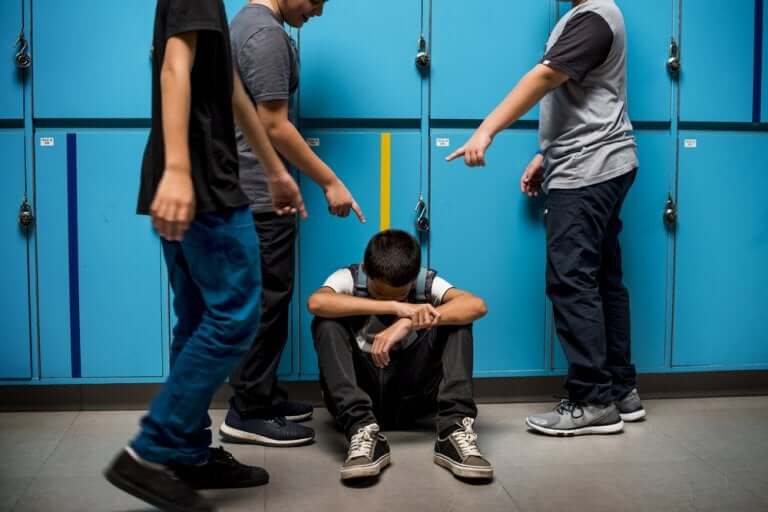How to Prevent Bullying in Elementary Schools

Bullying is a social phenomenon and a problem that occurs regardless of class, culture, or social level. It’s most prevalent in early adolescence, around the ages of 11 and 13. That’s why we’ve prepared this article for you on bullying in elementary schools.
It’s in the final years of elementary school that most cases of bullying develop and occur, even more than at secondary school. So, we need to work on this issue in the first years of primary education, and make the children fully aware of the issue of bullying and how it affects their classmates. If we do this, then the number of people affected by it will certainly be reduced in the short and long term.
Characteristics of elementary school students
We should bear in mind that elementary school students are right in the middle of their development regarding their capacities and skills. They acquire different skills at the following ages:
- Between the ages of 6 and 12, a child develops the feeling of autonomy and the need for independence.
- Between the ages of 7 and 9, children begin to become aware of social norms and a sense of embarrassment. Therefore, it’s important for them to feel accepted and valued by their friends. This is an ideal age to teach them to share, negotiate, cooperate and know how to accept failures in social relationships.

- Around the age of 9 or 10, they begin to make the distinction of their family life and the social contact with their friends, and start to develop the idea of loyalty to their friends. So, at this stage, they must learn the value of personal effort and setting aside their own personal comforts.
- From the age of 11, due to the physical changes that start to take place in their bodies, there’s an increase in insecurity. They also want to appear older and more mature. Because of this, they may proudly challenge authority. Their group of friends acquires a very relevant place in their lives.
In short, elementary school students are characterized by the need for approval from their peers, and the opinions of others are very important to them.
The first feelings of exclusion can start to appear when there are people who are different in some way from the social norm. Because of this, they have to learn to:
- Not judge people
- Put themselves in the other person’s shoes
- Look for solutions
- Be consistent with their actions
Taking measures against bullying in elementary schools
It’s important to take action against bullying in elementary schools. In this way, children will learn from an early age how to react positively to intolerance and provocation.
They’ll also be able to react in more positive ways to control their anger, to create new proposals, to seek solutions, and to stop believing that conflicts are always negative. In this way, they’ll achieve positive social relationships and non-violent interaction will be encouraged.
An inclusive school will always focus their education on promoting coexistence based on values and good practices, such as:
- Solidarity
- Respect
- Tolerance
- Participation
- Responsibility
- Commitment to the public
Furthermore, an inclusive school will guarantee that all students will have access to a quality education, based on equity and equal opportunities. In this educational context, they should address differences and give specific support and assistance to the most vulnerable people.
Similarly, the education system should build democratic social areas with a high level of participation. These areas should be socially enriched, facilitate learning, and emphasize the importance of living in harmony together. There should be a climate of learning, understanding, communication, good relationships, and openness to other groups.
It’s a question of focusing on true participation and fighting against any form of exclusion. This is an ongoing process, and the work is never completely finished.

Conclusion
In conclusion, we should note that one of the main purposes of education is to help each child develop fully in all areas of their life:
- Physical
- Cognitive
- Communicative
- Social
- Cultural
- Moral
- Emotional
Therefore, a harmonious balance in developing these dimensions will promote a positive coexistence. As a result, there will be positive repercussions and a significant reduction in bullying cases in schools.
Bullying is a social phenomenon and a problem that occurs regardless of class, culture, or social level. It’s most prevalent in early adolescence, around the ages of 11 and 13. That’s why we’ve prepared this article for you on bullying in elementary schools.
It’s in the final years of elementary school that most cases of bullying develop and occur, even more than at secondary school. So, we need to work on this issue in the first years of primary education, and make the children fully aware of the issue of bullying and how it affects their classmates. If we do this, then the number of people affected by it will certainly be reduced in the short and long term.
Characteristics of elementary school students
We should bear in mind that elementary school students are right in the middle of their development regarding their capacities and skills. They acquire different skills at the following ages:
- Between the ages of 6 and 12, a child develops the feeling of autonomy and the need for independence.
- Between the ages of 7 and 9, children begin to become aware of social norms and a sense of embarrassment. Therefore, it’s important for them to feel accepted and valued by their friends. This is an ideal age to teach them to share, negotiate, cooperate and know how to accept failures in social relationships.

- Around the age of 9 or 10, they begin to make the distinction of their family life and the social contact with their friends, and start to develop the idea of loyalty to their friends. So, at this stage, they must learn the value of personal effort and setting aside their own personal comforts.
- From the age of 11, due to the physical changes that start to take place in their bodies, there’s an increase in insecurity. They also want to appear older and more mature. Because of this, they may proudly challenge authority. Their group of friends acquires a very relevant place in their lives.
In short, elementary school students are characterized by the need for approval from their peers, and the opinions of others are very important to them.
The first feelings of exclusion can start to appear when there are people who are different in some way from the social norm. Because of this, they have to learn to:
- Not judge people
- Put themselves in the other person’s shoes
- Look for solutions
- Be consistent with their actions
Taking measures against bullying in elementary schools
It’s important to take action against bullying in elementary schools. In this way, children will learn from an early age how to react positively to intolerance and provocation.
They’ll also be able to react in more positive ways to control their anger, to create new proposals, to seek solutions, and to stop believing that conflicts are always negative. In this way, they’ll achieve positive social relationships and non-violent interaction will be encouraged.
An inclusive school will always focus their education on promoting coexistence based on values and good practices, such as:
- Solidarity
- Respect
- Tolerance
- Participation
- Responsibility
- Commitment to the public
Furthermore, an inclusive school will guarantee that all students will have access to a quality education, based on equity and equal opportunities. In this educational context, they should address differences and give specific support and assistance to the most vulnerable people.
Similarly, the education system should build democratic social areas with a high level of participation. These areas should be socially enriched, facilitate learning, and emphasize the importance of living in harmony together. There should be a climate of learning, understanding, communication, good relationships, and openness to other groups.
It’s a question of focusing on true participation and fighting against any form of exclusion. This is an ongoing process, and the work is never completely finished.

Conclusion
In conclusion, we should note that one of the main purposes of education is to help each child develop fully in all areas of their life:
- Physical
- Cognitive
- Communicative
- Social
- Cultural
- Moral
- Emotional
Therefore, a harmonious balance in developing these dimensions will promote a positive coexistence. As a result, there will be positive repercussions and a significant reduction in bullying cases in schools.
All cited sources were thoroughly reviewed by our team to ensure their quality, reliability, currency, and validity. The bibliography of this article was considered reliable and of academic or scientific accuracy.
- Gobierno Vasco. (2014). Heziberri 2020, Marco del modelo educativo pedagógico.Departamento de Educación, Política Lingüística y Cultura del Gobierno Vasco.
- Ortega-Ruiz, R., Orjuela L., Cabrera de los Santos, B., Calmaestra, J. y Mora-Merchán, J. (2014). Acoso escolar y ciberacoso: propuestas para la acción. Madrid: Save the Children.
- Rodríguez, N. (2006). Stop bullying: las mejores estrategias para prevenir y frenar el acoso escolar. Barcelona: RBA.
This text is provided for informational purposes only and does not replace consultation with a professional. If in doubt, consult your specialist.








